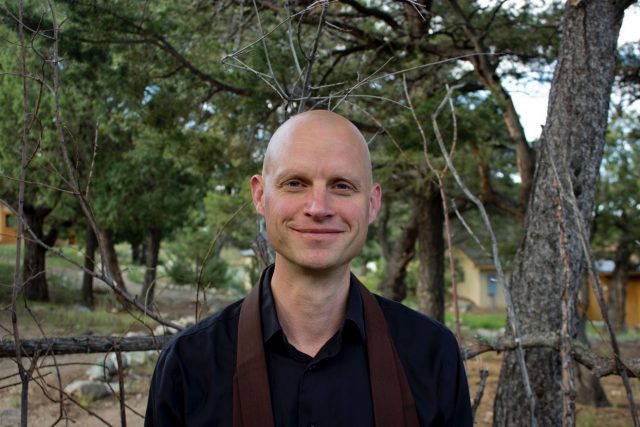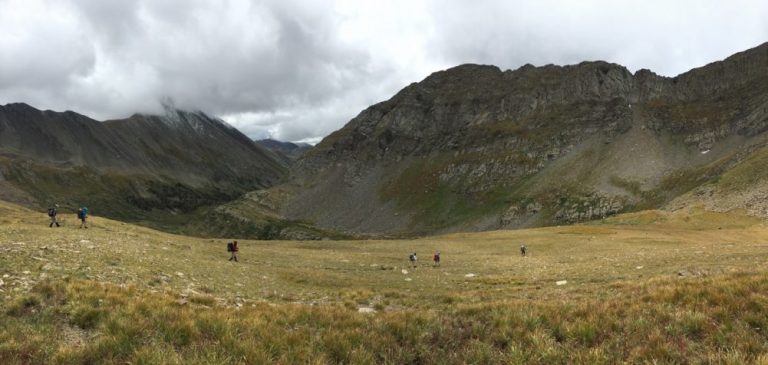Why carry Zen traditions and philosophies into the backcountry along with lightweight water purifiers, collapsible camp stoves, sleeping bags, tents, and pounds of trail mix? According to Zen priest Zenki Christian Dillo, being in the natural world enlivens meditation and reminds us of an easily forgotten truth: humans are a part of nature, too.
Dillo, who is the director of the Crestone Mountain Zen Center, has been leading small groups of his students and friends into wild areas of the western United States since 2012. He refers to these excursions as “wild dharma practice,” but also likes the phrase coined by one of his past retreatants: “living in the dirt.”
Though Dillo emphasized that wild dharma practice has no specific agenda or goal, it was clear after speaking with him that he is deeply concerned about the global environmental crisis. From his perspective, “living in the dirt”—even for just a few days and nights—can inform how we move our civilization forward with wisdom and compassion.

What is wild dharma practice?
Dharma practice typically occurs in a sheltered and civilized environment. It’s very formal. Our experiment is to take practice into the wild backyard, into the land rising above our monastery or elsewhere in the West, and see what happens.
Our trips last five days and four nights. Everything we bring has to fit into our backpacks. We emphasize local and organic food and bring as much as possible from our center’s garden. For example, we dehydrate fresh Colorado peaches and mix them in with homemade granola; we prepare homemade datenut bars instead of buying power bars; and we cook dehydrated fresh tomato sauce that we reheat on a camp stove.
What does a regular day look like?
We get up with the rising sun, sit two periods of zazen [meditation] under the open sky at our campsite, then do a little chanting—maybe the Heart Sutra or the Mountains and Waters Sutra by Dogen. Then we eat what I’ve been terming “mountain oryoki.” Oryoki is a structured form of silent eating in Zen: we sit in a circle, pass the bowls, and chant at certain times. It’s really beautiful in the camping context.
How so?
This ritual allows practitioners to relate to the food, the environment, the other retreatants, and their own bodies. An oryoki meal practiced with wholehearted attention leaves one feeling whole and nourished, both physically and mentally. Beauty, as I remember my teacher Zentatsu Baker Roshi say, is when the mind returns nourished from whatever activity it engages in.
Then what?
All packed up, we walk silently for an hour and a half, eventually bowing out of silence into another hour of walking during which people can converse. Lunch is on the trail, followed by more walking in the afternoon, also with a long silent period. At our new camp, after relaxing and eating mountain oryoki again, there’s a dharma circle: I give a talk or somebody brings a question. In a setting relatively undisturbed by invasive human activities, the global environmental crisis often comes up. So we let it. Sometimes we have a fire. Sometimes we just sit beneath the stars.
Related: Avalanche Zen
OK, that’s what it is, but how does it feel? Can you draw me into the experience of being out there?
Zen ritual, I like to say, is the interplay of stillness and activity. Taking the practice into the wild opens the possibility of experiencing that interplay with great clarity and intensity.
One of the experiences in my life when I’ve felt most alive—and for me Zen practice is about being fully alive—came in a side canyon of the Dirty Devil River in Utah. It was quite windy and unusually cold for late April. We had to put on all our layers to sit zazen in the elements. Sitting there, we could hear the wind hundreds of feet up the canyon, blowing down, building intensity through the trees. Then it would reach camp and hit our bodies. A moment later: absolute stillness. And then the next wave of wind would begin to build.
The practice of sitting enlivened the senses to the dynamic of stillness and activity. It made the body and mind more receptive to each moment of this phenomenon: the wind playing with the landscape, and with us.
By taking your practice outdoors, it seems like you’re really asking for interruption: the bird during breakfast, the gusts during zazen.
It’s the invitation of unpredictability. And, in a sense, it’s the invitation of awareness.
In our lineage of Soto Zen we make a distinction between consciousness and awareness. Consciousness is the modality of mind that sees the world as cognizable, predictable, sequential, and meaningful: it creates a stable container of human experience. By contrast, the world of awareness is unique, unpredictable, spatial instead of sequential, and actually kind of meaningless, in the sense that I’m not involved in creating my story: things are just happening.
When the world stops falling into categories, every moment is unique and appears as it is. Take a situation like mountain oryoki. You can’t even put your bowl on a stable surface! And you’re sitting on uneven ground, unlike in the zendo, so your body has to constantly adjust. Embedding ourselves in wildness has something to do with letting go, at least momentarily, of the modality of mind in which it often appears as if things are stable and permanent.
There’s a rich tradition in Chan and Zen literature, as well as contemporary writers, of going to the mountains, to the country, to deepen one’s practice. Does that inform what you do?
I find myself in a tradition that is present in the body—the desire of the body to be wild—as much as in any scriptural transmission. There’s an intellectual tradition of wisdom that says it’s a good idea to take your practice into the mountains, but there’s also a bodily mind that already knows this is an activity of wisdom. Our own intuition meets the old poems and stories in this way.
Related: Bonfire Buddha
The ancient Chinese master Fayen says: “Students of Zen need only act according to conditions to realize the Way. If you must understand the meaning of buddhanature then just pay attention to what’s going on . . . just do what is appropriate to the moment! Take care!” In my experience, this sounds remarkably like what the storm says to the backpacker hiking at timberline in the mountains. Run! Take shelter! Take care! React right now to this lightning bolt! Is raw contact with wild nature a kind of shortcut to the way, or at least a strong nudge in the direction of Fayen’s advice?
Let’s add to Fayen for a moment. Dogen says that to carry the self forward and actualize the ten thousand things is delusion, but to let the ten thousand things come forward and actualize the self is enlightenment. Any kind of elemental encounter—crossing a stream, meeting a bear, or extreme weather—requires us to respond. We want to cultivate what I call our “response-ability” at all times, in all situations, but the natural world does make for a particularly visceral, immediate experience. One has to take Fayen’s advice just to travel through a place and a situation unharmed. It’s empowering. We get taught our ability to respond in wild circumstances, and that’s invaluable.
How does a wild dharma trip flow into the next week, the next month, the next year?
I don’t think these trips are intended to produce a special experience that is categorically different from daily life. The goal is a kind of openness through exposure, that’s all. Something might happen—like a realization of freedom, or maybe of profound connectivity—or something might not happen. Either way, it’s OK.
Let’s say a special experience does happen: I would leave it unanalyzed, and just let it osmotically seep into daily life. When the experience has genuinely influenced body and mind, it will interact with daily life on its own. Why push it? Why try to reach for something?
You’ve said that wild lands appear to be “the remedy for alienation.” It seems as though people are reaching for something. For instance, the national parks are seeing record-breaking numbers of visitors each year.
There are various layers of alienation. The mind can be alienated from the body; the body can be alienated from the mind. The mind can even be alienated from itself, like when I’m desperately trying to grasp my own thinking. I can feel alienated from you, and I can feel alienated from nature, and overlook the fact that I am already nature.
A wild context provides opportunities to break through that experience of alienation. That’s good. But then the next question comes up: do I only temporarily counterbalance my alienated life with a weekend getaway to the woods? I think it becomes a real remedy if my experience in the wilds is a seed that can grow and mature, and actually begin to transform our human world through wisdom and compassion. And that’s urgently needed.
Why?
Climate disruption, the biodiversity crisis, pollution, population: we have to rethink and find a better way to enact civilization. But it’s a delicate balance. I don’t want to destroy the last wild places on the earth with my desire to learn from them. That’s why we only do these wild dharma trips once or twice a year. It’s appropriate, I think, to mostly leave the country to the black bear and the mountain lion and the eagle—mostly. We share. We overlap. But the idea that the wilds promise a better life? That neglects our responsibility as humans to create a civilization that coexists with all beings.
Thank you for subscribing to Tricycle! As a nonprofit, we depend on readers like you to keep Buddhist teachings and practices widely available.
